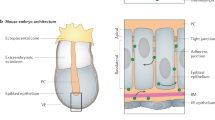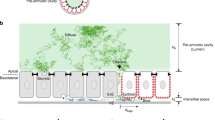Abstract
Generating morphogenetic gradients during early development is a fundamental step of positional signaling, which ultimately results in patterning and cell specialization. Based on morphogens propagation from cells to cells, we have presented a biophysical model in Holcman et al. (in press), where gradients and boundaries between different morphogenetic regions can be generated. In that theory, morphogens are transcription factors which induce their own activation and at the same time propagate in a cell ensemble.
We analyze here a variant version of the biophysical model proposed in Holcman et al. (in press), where now morphogens can form dimers. As a result, gradients are smoother and borders are much sharper. Because random perturbations of a gradient can affect the precise location of the boundary between two morphogenetic regions, we also analyze these fluctuations and in particular, we obtain an analytic expression for the variance of the boundary location as a function of the variance of the random perturbations. This formula can be used to study the noise intrinsic effect on the boundary position between morphogenetic regions, which can be at the origin of interindividual variations.
Similar content being viewed by others
References
Bishop, K.M., Garel, S., Nakagawa, Y., Rubenstein, J.L., O’Leary, D.D., 2003. Emx1 and Emx2 cooperate to regulate cortical size, lamination, neuronal differentiation, development of cortical efferents, and thalamocortical pathfinding. J. Comp. Neurol. 457(4), 345–360.
Brodski, C., Weisenhorn, D.M., Signore, M., Sillaber, I., Oesterheld, M., Broccoli, V., Acampora, D., Simeone, A., Wurst, W., 2003. Location and size of dopaminergic and serotonergic cell populations are controlled by the position of the midbrain-hindbrain organizer. J. Neurosci. 23(10), 4199–4207.
Brunet, I., Weinl, C., Piper, M., Trembleau, A., Volovitch, M., Harris, W., Prochiantz, A., Holt, C., 2005. The transcription factor Engrailed-2 guides retinal axons. Nature 438(7064), 94–98.
Crick, F., 1970. Diffusion in embryogenesis. Nature 225(5231), 420–422.
Eldar, A., Barkai, N., 2005. Interpreting clone-mediated perturbations of morphogen profiles. Dev. Biol. 278(1), 203–207. Review.
Entchev, E.V., Gonzalez-Gaitan, M.A., 2002. Morphogen gradient formation and vesicular trafficking. Traffic 3(2), 98–109. Review.
Gierer, A., Meinhardt, H., 1972. A theory of biological pattern formation. Kybernetik 12, 30–39.
Holcman, D., Kasatkin, V., Prochiantz, A., in press. Modeling homeoprotein intercellular transfer unveils a parsimonious mechanism for gradient and boundary formation in early brain development. J. Therm. Biol.
Houchmandzadeh, B., Wieschaus, E., Leibler, S., 2002. Establishment of developmental precision and proportions in the early Drosophila embryo. Nature 415(6873), 798–802.
Houchmandzadeh, B., Wieschaus, E., Leibler, S., 2005. Precise domain specification in the developing Drosophila embryo. Phys. Rev. E Stat. Nonlinear Soft Matter. Phys. 72, 061920.
Howard, M., ten Wolde, P.R., 2005. Finding the center reliably: robust patterns of developmental gene expression. Phys. Rev. Lett. 95(20), 208103.
Kerszberg, M., Wolpert, L., 1998. Mechanisms for positional signalling by morphogen transport: a theoretical study. J. Theor. Biol. 191(1), 103–114.
Lander, A.D., Nie, Q., Wan, F.Y., 2002. Do morphogen gradients arise by diffusion? Dev. Cell 2(6), 785–796.
McHale, P., Rappel, W.J., Levine, H., 2006. Embryonic pattern scaling achieved by oppositely directed morphogen gradients. Phys. Biol. 3(2), 107–120.
Meinhardt, H., 1983. Cell determination boundaries as organizing regions for secondary embryonic fields. Dev. Biol. 96, 375–385.
Monk, N.A., 1998. Restricted-range gradients and travelling fronts in a model of juxtacrine cell relay. Bull. Math. Biol. 60(5), 901–918.
Prochiantz, A., Joliot, A., 2003. Can transcription factors function as cell–cell signalling molecules? Nat. Rev. Mol. Cell Biol. 4(10), 814–819.
Schwarz, M., Cecconi, F., Bernier, G., Andrejewski, N., Kammandel, B., Wagner, M., Gruss, P., 2000. Spatial specification of mammalian eye territories by reciprocal transcriptional repression of Pax2 and Pax6. Development 127(20), 4325–4334.
Simeone, A., 2000. Positioning the isthmic organizer where Otx2 and Gbx2 meet. Trends Genet. 16, 237–240.
Stenman, J., Yu, R.T., Evans, R.M., Campbell, K., 2003. Tlx and Pax6 co-operate genetically to establish the pallio-subpallial boundary in the embryonic mouse telencephalon. Development 130(6), 1113–1122.
Toresson, H., Potter, S.S., Campbell, K., 2000. Genetic control of dorsal-ventral identity in the telencephalon: opposing roles for Pax6 and Gsh2. Development 127(20), 4361–4371.
Turing, A., 1952. The chemical basis of morphogenesis. Philos. Trans. R. Soc. B 237, 37–72.
Vincent, J.P., Dubois, L., 2002. Morphogen transport along epithelia, an integrated trafficking problem. Dev. Cell 3(5), 615–623.
Wolpert, L., 1969. Positional information and the spatial pattern of cellular differentiation. J. Theor. Biol. 25(1), 1–47.
Wolpert, L., 1996. One hundred years of positional information. Trends Genet. 12(9), 359–364. Review.
Yun, K., Potter, S., Rubenstein, J.L., 2001. Gsh2 and Pax6 play complementary roles in dorsoventral patterning of the mammalian telencephalon. Development 128(2), 193–205.
Author information
Authors and Affiliations
Corresponding author
Rights and permissions
About this article
Cite this article
Kasatkin, V., Prochiantz, A. & Holcman, D. Morphogenetic Gradients and the Stability of Boundaries Between Neighboring Morphogenetic Regions. Bull. Math. Biol. 70, 156–178 (2008). https://doi.org/10.1007/s11538-007-9246-5
Received:
Accepted:
Published:
Issue Date:
DOI: https://doi.org/10.1007/s11538-007-9246-5




